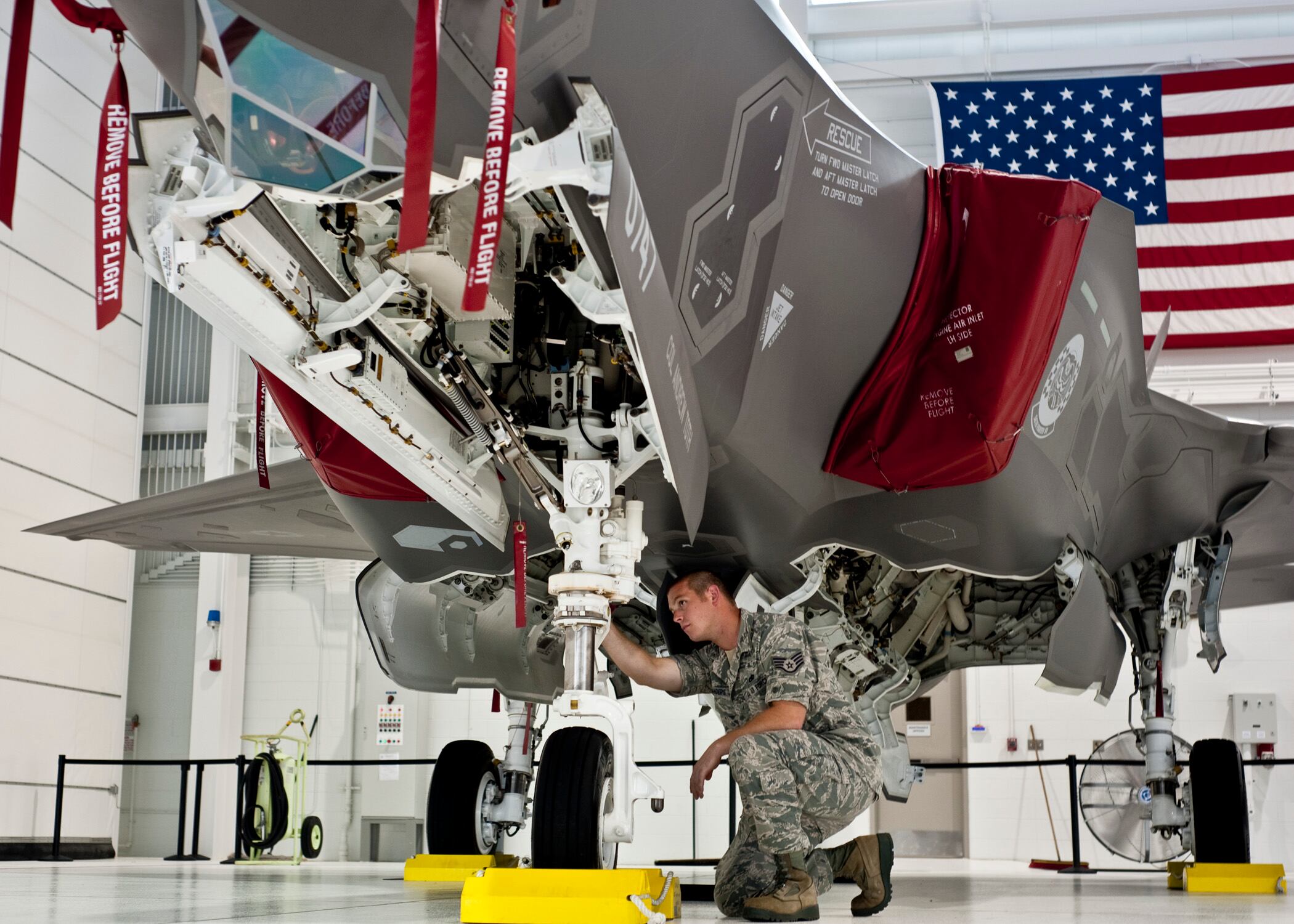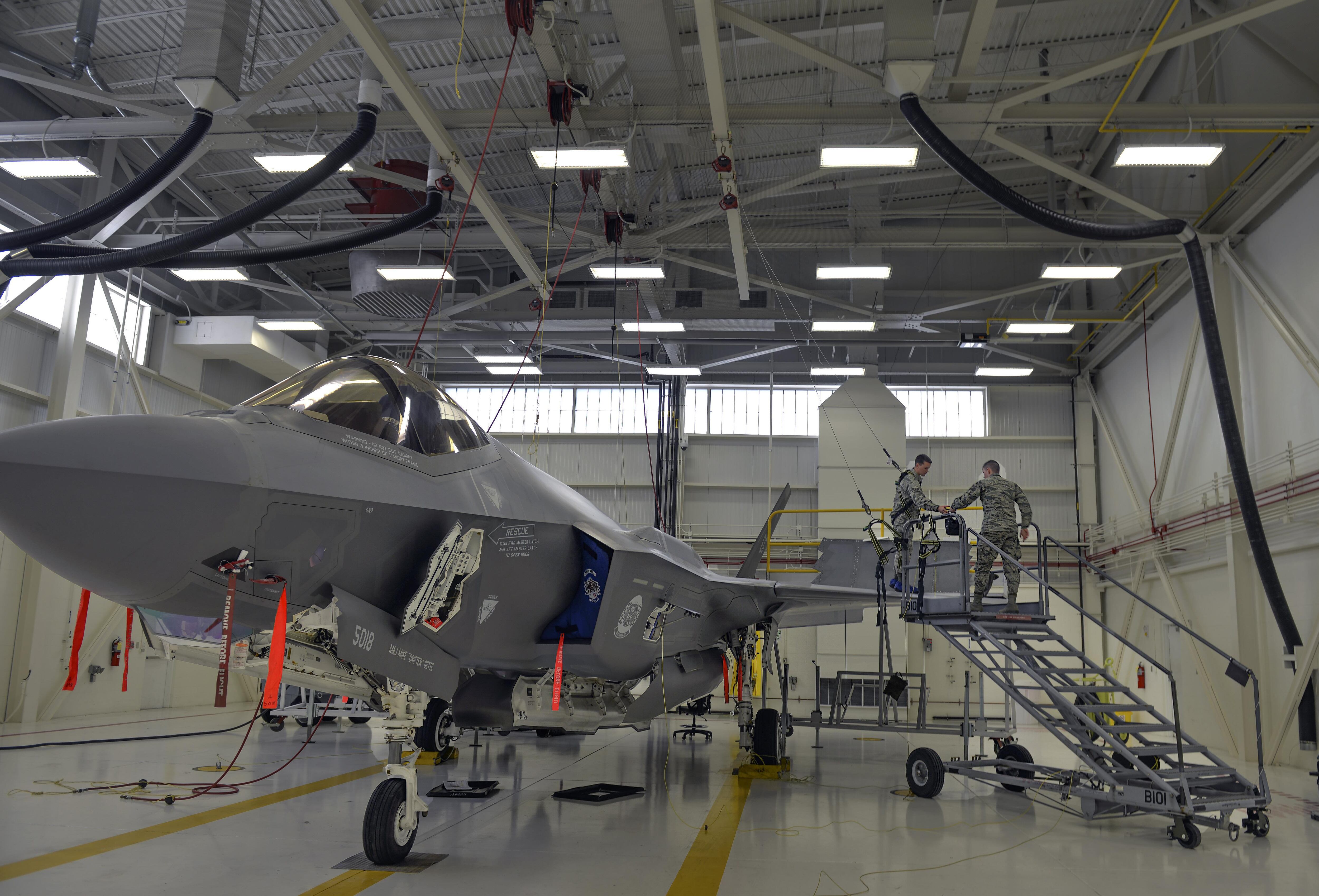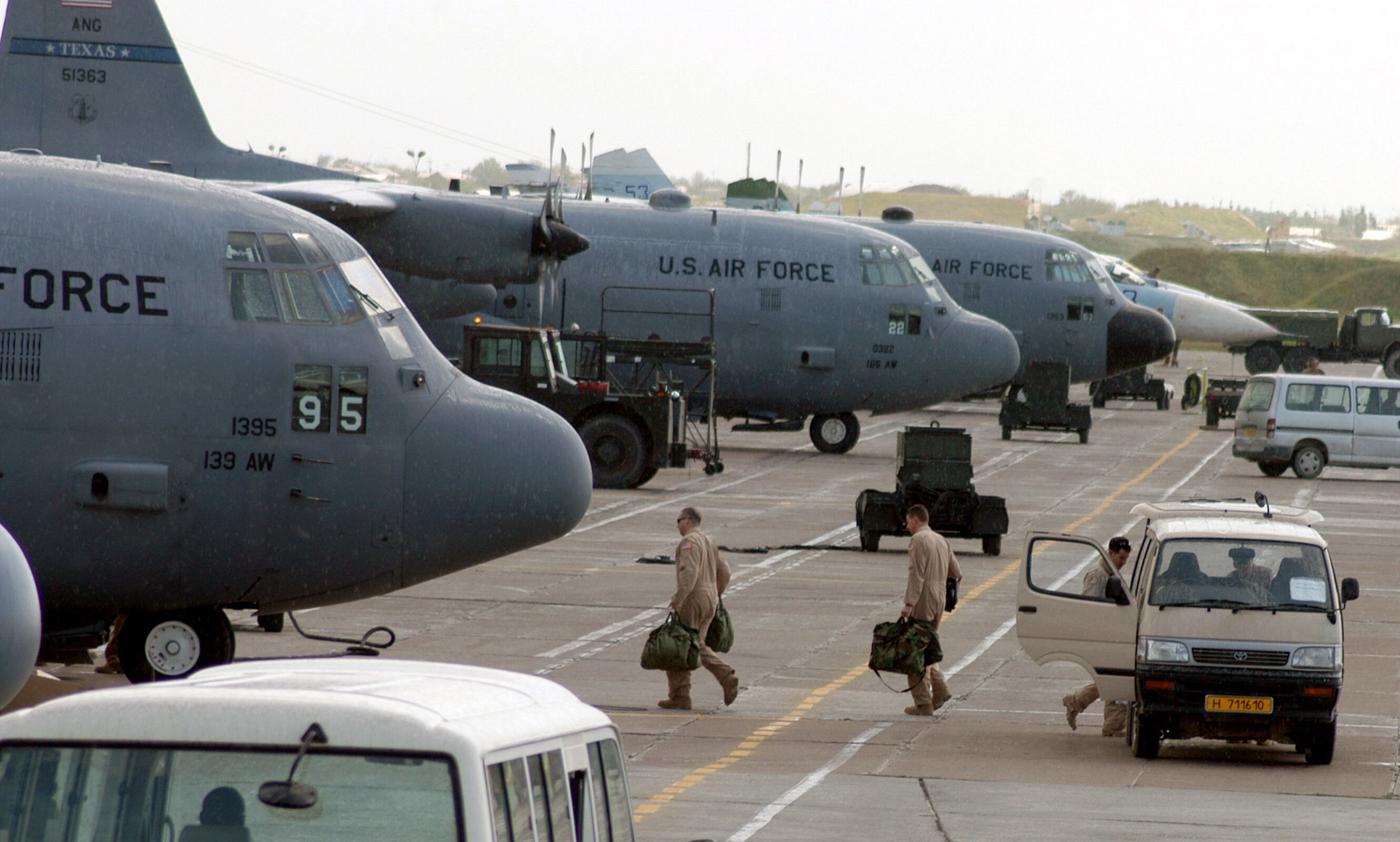WASHINGTON — A lack of spare parts and technical data, poor training of maintainers, and a lagging effort to expand repair depots are dragging down the U.S. military’s ability to keep the F-35 Joint Strike Fighter in the air, a government watchdog said in a report released Thursday.
And the problems hindering the military from taking over more sustainment activities from the prime F-35 contractor, Lockheed Martin, will cost the government billions of dollars each year if a more cost-effective strategy isn’t found, the Government Accountability Office wrote in its report.
The F-35 and its advanced capabilities make it a formidable weapon in the United States’ arsenal, GAO said. But if the plane can’t get off the ground because of problems with its maintenance and sustainment, the report added, that “valuable edge” does the Air Force, Navy and Marine Corps no good.
The three services combined have more than 450 F-35s, and the Defense Department eventually plans to buy a total of almost 2,500 fighters with a life-cycle cost of more than $1.7 trillion.
The vast majority of that life-cycle cost, $1.3 trillion, comes from the operation and sustainment of the jet, GAO said.
But the F-35′s availability has lagged for years, and if a war broke out today, many fighters would be unavailable to fight. In March 2023, GAO said, the mission-capable rate for all F-35s was at 55%. That’s well below the 70% mission-capable goal the Air Force has for its F-35As, and the 75% goal for the Navy and Marine Corps’ F-35B and F-35C variants.
Key lawmakers and watchdog groups have regularly criticized the military and Lockheed Martin for failing to improve the F-35′s availability. Lt. Gen. Michael Schmidt, who directs the F-35 program, has launched an effort he calls the “war on readiness” to fix the issue, although public details remain scarce.
GAO’s new report presents a deep dive into the many issues that combine to drag down F-35 availability — particularly in obtaining parts to fix broken jets.
The Pentagon agreed with GAO’s recommendations to reconsider its sustainment approaches to the F-35; decide whether the government should take over more responsibilities; consider whether changes to the Navy and Air Force are necessary to better sustain the jet; decide what technical data the services need to support any changes to maintenance processes; and identify what resources might be necessary.
In a statement from the F-35 Joint Program Office, Schmidt said the program continues to work on a “more resilient sustainment structure” and grow its capacity and efficiency worldwide. This includes standing up a network for repair, transportation and warehousing faster, and using incentives to industry to make more F-35s available at an affordable cost.
Lockheed Martin said in a statement to Defense News it’s ready to work with the government as it plans for the future of the F-35′s sustainment. The company added it has long worked with the government to fix the issues that degrade F-35 readiness through its reliability and maintenance program.
A spare parts conundrum
The backlog of broken spare parts that need fixed has more than doubled since spring 2019, GAO said, from 4,300 to more than 10,000.
It now takes an average of 141 days to repair a broken spare part — far above the F-35 program’s goal of 60 days — and nearly three-quarters of those parts are sent back to the original equipment manufacturer for repair.
Rather than wait nearly five months for a repaired part, GAO said the F-35 Joint Program Office often buys new parts at a higher cost. This helps get the fighter back in the air faster, GAO acknowledged, but it drives up sustainment costs.
Pentagon officials do not think it’s a sustainable strategy.

Program officials told GAO that military service depots can repair parts more quickly than the original manufacturer, in about 72 days on average. The parts that most frequently lead to an F-35 being unable to carry out its mission include its canopy, engine, distributed aperture system sensor and nacelle vent fan.
But the program’s habit of buying new parts instead of fixing broken ones is siphoning money that could go to establishing repair activities at six depots. Furthermore, the F-35 program has fallen 12 years behind schedule in setting up those activities, GAO said, in part because of inadequate funding as the military focuses more on buying new jets than on sustaining existing ones.
The military is now able to repair 44 of the 68 components at F-35 depots including Ogden Air Logistics Complex at Hill Air Force Base in Utah as well as the Fleet Readiness Center East at Marine Corps Air Station Cherry Point in North Carolina. Parts that depots will be able to repair include the fighter’s landing gear, ejection seat and power thermal management system.
However, the depots will be unable to repair all parts until 2027, the Pentagon projects. These delays have led to slow repair times, lower readiness and a growing backlog of broken parts.
A lack of spare parts was a significant problem for 10 of 15 F-35 installations the GAO surveyed, and last year fighters were unable to operate about 27% of the time because a spare part was unavailable.
Maintainers told GAO they often can’t do their jobs because they don’t have enough parts or don’t know when they will receive spares. The maintainers identified Lockheed Martin’s supply chain process as the cause.
The report singled out the F-35′s distributed aperture system sensor as an example of a problematic part. This sensor, made by RTX subsidiary Raytheon, provides 360-degree situational awareness and is intended to allow an F-35 pilot to detect potential threats, such as missiles.
One installation has resorted to “workarounds” to keep F-35s flying with broken sensors when they’re waiting for replacement parts to be delivered, GAO said, but this degrades the jet’s ability to fully carry out its mission.
The F-35 Joint Program Office told GAO it is looking for ways to fix the spare parts issue, including potentially entering into a performance-based logistics contract with Lockheed Martin. But buying enough spare parts and supplies to have each installation fully stocked would be too expensive, officials told the watchdog.
F-35 installations also often lack enough support equipment on the flight line, including equipment needed to provide the jet with electric or hydraulic power, or to tow it.
At some installations, it is common practice for squadrons to borrow support equipment from other squadrons. But when an F-35 squadron deploys and takes most of the installation’s support equipment, that leaves the remaining squadrons “scrambling” to find equipment to maintain the remaining jets.
That support equipment frequently breaks, GAO said, and because it is proprietary, contractors must come in to fix it — a process that can take months.
In the last few years, the F-35 program has grown to conclude it can’t afford the current strategy of contractor-led sustainment of the jet. By 2036, GAO wrote in a 2021 report, contractor-led sustainment of the jet will be $6 billion more than the military can afford in that year alone.
Haunted by ‘acquisition malpractice’
Decisions made at the dawn of the F-35 are also coming back to haunt it — particularly the Pentagon’s early decision not to obtain technical data on the fighter from Lockheed Martin, and the considerable amount of concurrency in the program.
Concurrency refers to when a program’s development, testing, production and fielding phases overlap. In the case of the F-35 program, the jet has continued to undergo testing and refinement for more than a decade after the first lot was built and delivered to the U.S. military and international customers.
The F-35 is now in its 15th production lot, and GAO said aircraft as recent as lot 12 required repairs and modifications after testing showed major changes were necessary.
There are now at least 14 different versions of the F-35 undergoing work at depots, officials at several locations told GAO.
When jets must receive modifications, the work further strains depots’ ability to conduct day-to-day repairs. Depot officials told GAO upgrading these jets takes thousands of workload hours apiece and requires F-35s to stay in depots for an extended period.

Without necessary and complete technical data from Lockheed Martin and its subcontractors, repair times have lagged. When the F-35 program began, GAO said, the Pentagon thought it would be more cost-effective to have contractors handle the bulk of the jet’s sustainment. As a result, the Pentagon didn’t require Lockheed to hand over the technical data that would allow the military to “organically” handle maintenance itself.
Air Force Secretary Frank Kendall has repeatedly criticized that decision, earlier this year calling it “a serious mistake” the service won’t repeat on its sixth-generation Next Generation Air Dominance fighter.
The acquisition philosophy in vogue at the time of the F-35 program’s launch two decades ago, dubbed Total System Performance, meant the contractor on the program would own it for the system’s entire life cycle, Kendall said during a May breakfast with reporters.
This creates “a perpetual monopoly,” Kendall explained, and amounts to “acquisition malpractice” on the F-35.
Officials at an unidentified depot told GAO that maintenance manuals for some key parts are “ambiguous and rarely are detailed enough for depot personnel to make the repair.”
“As a result, depot personnel not only cannot fix the part, but they cannot learn and understand how to fix the part,” the watchdog wrote.
This is proving to be a particular problem as the military tries to add a software maintenance repair component to depots. Lockheed Martin and its subcontractors wrote the fighters more than 8 million lines of code, and they handle the management of and repairs for this code.
The government’s F-35 program has wanted to take over this sustainment for more than five years, and the military has long done the same work on other aircraft. But the program’s inability to acquire the source code necessary to sustain the F-35′s software has prevented it from taking over that work.
In its statement to Defense News, Lockheed Martin said it delivers all data to the government required under its contracts “and is committed to providing data for the Department of Defense to sustain the aircraft under applicable sustainment contracts.”
“The U.S. government has unlimited rights to all operation, maintenance, installation and training data delivered to the government that allows the DoD to maintain and operate the aircraft,” Lockheed added.
The training process for service members to maintain the F-35 is also lacking, GAO said. Maintainers told GAO they mainly learned how to fix the jet while on the job. Initial Lockheed Martin-led training mainly relied on PowerPoint slides in a classroom, with limited hands-on lessons, GAO said.
Training personnel acknowledged to GAO the maintenance training is “poor and inadequate,” adding that because Lockheed Martin runs the training, the firm controls what information is presented to maintainers.
“Since so much of the technical data used to maintain the aircraft is proprietary and unavailable to the military services, trainers in the military services cannot develop effective training programs for maintainers,” GAO wrote.
The situation differs considerably from F-15 and F-16 maintenance, which includes detailed manuals spelling out how the systems operate that allow maintainers to troubleshoot nagging problems.
But at one location, F-35 maintainers told GAO that “they have access to so little technical information on the aircraft that they do not fully understand the aircraft or how to troubleshoot common problems.”
This means they regularly must consult contractor personnel to help with these maintenance tasks, GAO said. In one case, maintainers told the watchdog, a unit that had trouble with an F-35′s ejection seat had to transport a contractor by helicopter to a ship to fix the part.
Stephen Losey is the air warfare reporter for Defense News. He previously covered leadership and personnel issues at Air Force Times, and the Pentagon, special operations and air warfare at Military.com. He has traveled to the Middle East to cover U.S. Air Force operations.





